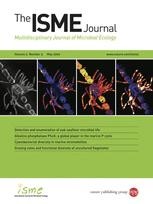-
Views
-
Cite
Cite
Yuki Morono, Takeshi Terada, Noriaki Masui, Fumio Inagaki, Discriminative detection and enumeration of microbial life in marine subsurface sediments, The ISME Journal, Volume 3, Issue 5, May 2009, Pages 503–511, https://doi.org/10.1038/ismej.2009.1
Close - Share Icon Share
Abstract
Detection and enumeration of microbial life in natural environments provide fundamental information about the extent of the biosphere on Earth. However, it has long been difficult to evaluate the abundance of microbial cells in sedimentary habitats because non-specific binding of fluorescent dye and/or auto-fluorescence from sediment particles strongly hampers the recognition of cell-derived signals. Here, we show a highly efficient and discriminative detection and enumeration technique for microbial cells in sediments using hydrofluoric acid (HF) treatment and automated fluorescent image analysis. Washing of sediment slurries with HF significantly reduced non-biological fluorescent signals such as amorphous silica and enhanced the efficiency of cell detachment from the particles. We found that cell-derived SYBR Green I signals can be distinguished from non-biological backgrounds by dividing green fluorescence (band-pass filter: 528/38 nm (center-wavelength/bandwidth)) by red (617/73 nm) per image. A newly developed automated microscope system could take a wide range of high-resolution image in a short time, and subsequently enumerate the accurate number of cell-derived signals by the calculation of green to red fluorescence signals per image. Using our technique, we evaluated the microbial population in deep marine sediments offshore Peru and Japan down to 365 m below the seafloor, which provided objective digital images as evidence for the quantification of the prevailing microbial life. Our method is hence useful to explore the extent of sub-seafloor life in the future scientific drilling, and moreover widely applicable in the study of microbial ecology.




